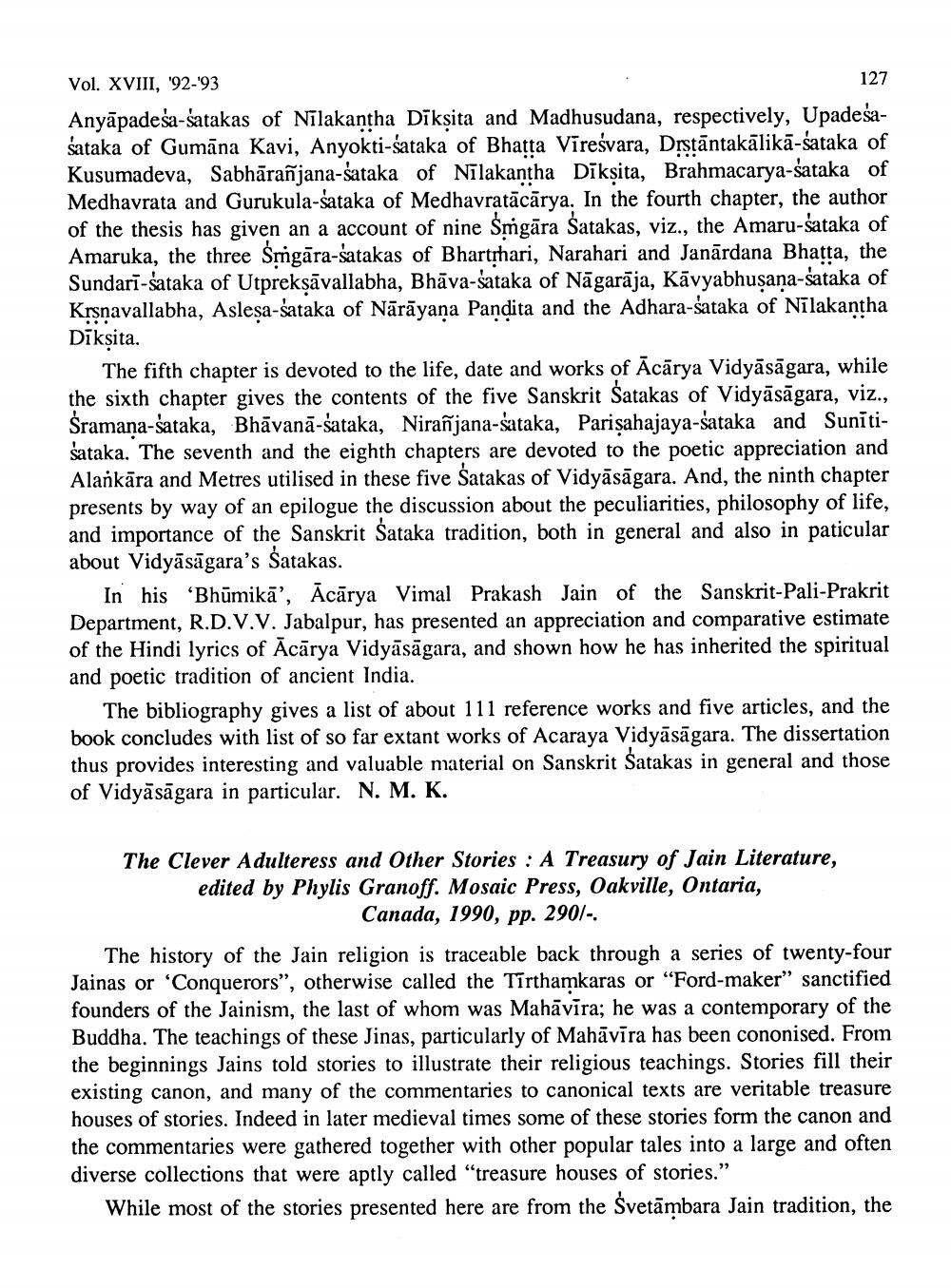________________
127
Vol. XVIII, '92-'93 Anyāpadesa-Satakas of Nilakantha Dīksita and Madhusudana, respectively, Upadesasataka of Gumāna Kavi, Anyokti-sataka of Bhatta Vireśvara, Drstāntakālikā-sataka of Kusumadeva, Sabhārañjana-Sataka of Nīlakantha Dīksita, Brahmacarya-sataka of Medhavrata and Gurukula-sataka of Medhavratācārya. In the fourth chapter, the author of the thesis has given an a account of nine Smgāra Šatakas, viz., the Amaru-sataka of Amaruka, the three Smgāra-satakas of Bhartrhari, Narahari and Janārdana Bhatta, the Sundari-sataka of Utpreksāvallabha, Bhāva-Sataka of Nagarāja, Kāvyabhusana-sataka of Krsnavallabha, Aslesa-Sataka of Nārāyana Pandita and the Adhara-šataka of Nīlakantha Dīkṣita.
The fifth chapter is devoted to the life, date and works of Ācārya Vidyāsāgara, while the sixth chapter gives the contents of the five Sanskrit Satakas of Vidyāsāgara, viz., Sramana-Sataka, Bhāvanā-sataka, Niranjana-Sataka, Parisahajaya-sataka and Sunītišataka. The seventh and the eighth chapters are devoted to the poetic appreciation and Alankāra and Metres utilised in these five Satakas of Vidyāsāgara. And, the ninth chapter presents by way of an epilogue the discussion about the peculiarities, philosophy of life, and importance of the Sanskrit Sataka tradition, both in general and also in paticular about Vidyāsāgara's Satakas.
In his ‘Bhūmikā', Ācārya Vimal Prakash Jain of the Sanskrit-Pali-Prakrit Department, R.D.V.V. Jabalpur, has presented an appreciation and comparative estimate of the Hindi lyrics of Ācārya Vidyāsāgara, and shown how he has inherited the spiritual and poetic tradition of ancient India.
The bibliography gives a list of about 111 reference works and five articles, and the book concludes with list of so far extant works of Acaraya Vidyāsāgara. The dissertation thus provides interesting and valuable material on Sanskrit Satakas in general and those of Vidyāsāgara in particular. N. M. K.
The Clever Adulteress and Other Stories : A Treasury of Jain Literature, edited by Phylis Granoff. Mosaic Press, Oakville, Ontaria,
Canada, 1990, pp. 290/-.
The history of the Jain religion is traceable back through a series of twenty-four Jainas or 'Conquerors", otherwise called the Tirthamkaras or "Ford-maker" sanctified founders of the Jainism, the last of whom was Mahāvīra; he was a contemporary of the Buddha. The teachings of these Jinas, particularly of Mahāvīra has been cononised. From the beginnings Jains told stories to illustrate their religious teachings. Stories fill their existing canon, and many of the commentaries to canonical texts are veritable treasure houses of stories. Indeed in later medieval times some of these stories form the canon and the commentaries were gathered together with other popular tales into a large and often diverse collections that were aptly called "treasure houses of stories.”
While most of the stories presented here are from the Svetāmbara Jain tradition, the




